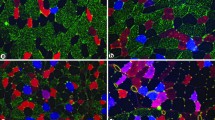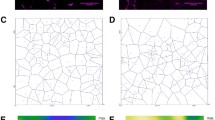Summary
The number of capillaries per fiber, per mm2, around each fiber type and relative to fiber area was determined in six untrained subjects (UT) and six elite cross-country skiers (ET). Average values for maximal oxygen uptake were 49.8 ml·kg−1·min−1 (UT) and 77.9 ml·kg−1·min−1 (ET). Type I fibers constituted 39.2% (UT) and 68.6% (ET), type II A fibers 39.6% (UT) and 19.2% (ET), while 12.8% (UT) and 6.6% (ET) of the fibers were type II B. The mean fiber area for the type II A fibers was significantly greater (p<0.01) than the areas for type I and II B in the untrained group.
The average numbers of capillaries around each fiber type (CA) were 4.76-4.84-2.94 (UT) and 7.79-6.63-4.5 (ET) for type I, II A, and II B, respectively. There was a significant difference (p<0.01) in the CA values relative to fiber area for all fiber types in both groups, being highest for type I and lowest for type II B. The CA increased linearly with increasing size of the fibers for all fiber types in both groups.
The mitochondrial content was determined semiquantitatively for each fiber type. The differences in capillary supply between the fiber types are accompanied by similar differences in mitochondrial content.
The results indicate that endurance training increases the capillary supply of all fiber types in the human quadriceps muscle. The fact that light microscopical studies have given lower capillarization values than those obtained with the electron microscope is discussed.
Similar content being viewed by others
References
Andersen, P.: Capillary density in skeletal muscle of man. Acta Physiol. Scand. 95, 203–205 (1975)
Andersen, P., Henriksson, J.: Capillary supply of the quadriceps femoris muscle of man: Adaptive response to exercise. J. Physiol. 270, 677–690 (1977)
Bergström, J.: Muscle electrolytes in man. Scand. J. Clin. Lab. Invest. Suppl. 68 (1962)
Brodal, P., Ingjer, F., Hermansen, L.: Capillary supply of skeletal muscle fibers in untrained and endurance trained men. Am. J. Physiol. 232, H705-H712 (1977)
Buchthal, F., Schmalbruch, H.: Contraction times and fibre types in intact human muscle. Acta Physiol. Scand. 79, 435–452 (1970)
Bylund, A.-C., Bjurö, T., Cederblad, G., Holm, J., Lundholm, K., Sjöström, M., Ängquist, K. A., Scherstén, T.: Physical training in man. Skeletal muscle metabolism in relation to muscle morphology and running ability. Eur. J. Appl. Physiol. 36, 151–169 (1977)
Costill, D. L., Daniels, J., Evans, W., Fink, W., Krahenbuhl, G., Saltin, B.: Skeletal muscle enzymes and fiber composition in male and female track athletes. J. Appl. Physiol. 40, 149–154 (1976a)
Costill, D. L., Fink, W. J., Pollock, M. L.: Muscle fiber composition and enzyme activities of elite distance runners. Med. Sci. Sports 8, 96–100 (1976b)
Dubowitz, V., Brooke, M. H.: Muscle biopsy: A modern approach, pp. 475. London, Philadelphia, Toronto: Saunders 1973
Eberstein, A., Goodgold, J.: Slow and fast twitch fibers in human skeletal muscle. Am. J. Physiol. 215, 535–541 (1968)
Essén, B., Jansson, E., Henriksson, J., Taylor, A. W., Saltin, B.: Metabolic characteristics of fibre types in human skeletal muscles. Acta Physiol. Scand. 95, 153–165 (1975)
Collnick, P. D., Ianuzzo, C. D., King, D. W.: Ultrastructural and enzyme changes in muscle with exercise. In: Muscle Metabolism During Exercise, pp. 69–85. New York, London: Plenum Press 1971
GrØnnerØd, O., Dahl, H. A., Vaage, O.: Easy typing of human muscle fibers in sequentially preincubated myofibrillar ATP-ase sections. Proc. Int. Union Physiol. Sci. 13, 285 (1977)
Hanson, J.: Effects of repetitive stimulation on membrane potentials and twitch in human and rat muscle fibers. Acta Physiol. Scand. 92, 238–248 (1974)
Henriksson, J., Reitman, J. S.: Quantitative measures of enzyme activities in type I and type II muscle fibers of man after training. Acta Physiol. Scand. 97, 392–397 (1976)
Hermansen, L., Saltin, B.: Oxygen uptake during maximal treadmill and bicycle exercise. J. Appl. Physiol. 26, 31–37 (1969)
Hermansen, L., Wachtlova, M.: Capillary density of skeletal muscle in well-trained and untrained men. J. Appl. Physiol. 30, 860–863 (1971)
Hoppeler, H., Lüthi, P., Claassen, H., Weibel, E. R., Howard, J.: The ultrastructure of the normal human skeletal muscle. A morphometric analysis on untrained men, women and well-trained orienteers. Pfluegers Arch. 344, 217–232 (1973)
Ingjer, F.: A method for correlating ultrastructural and histochemical data from individual muscle fibers. Histochemistry 54, 169–172 (1977)
Ingjer, F.: Maximal aerobic power related to the capillary supply of the quadriceps femoris muscle in man. Acta Physiol. Scand. (in press) (1978)
Ingjer, F., Brodal, P.: Capillary supply of skeletal muscle fibers in untrained and endurance-trained women. Eur. J. Appl. Physiol. 38, 291–299 (1978)
Jansson, E., Kaijser, L.: Muscle adaptation to extreme training in man. Acta Physiol. Scand. 100, 315–324 (1977)
Kamon, E., Pandolf, K. B.: Maximal aerobic power during laddermill climbing, uphill running, and cycling. J. Appl. Physiol. 32, 467–473 (1972)
Kiessling, K. H., Piehl, K., Lundquist, C. G.: Effect of physical training on ultrastructural features in human skeletal muscle. In: Muscle Metabolism During Exercise, pp. 97–101. New York, London: Plenum Press 1971
McArdle, W. D., Katch, F. I., Pecher, G. S.: Comparison of continuous and discontinuous treadmill and bicycle tests for max VO2. Med. Sci. Sports 5, 156–160 (1973)
McArdle, W. D., Magel, J. R.: Physical work capacity and maximum oxygen uptake in treadmill and bicycle exercise. Med. Sci. Sports 2, 118–123 (1970)
Mitchell, J., Sproule, B., Charman, C.: The physiological meaning of the maximal oxygen intake test. J. Clin. Invest. 37, 538–546 (1958)
Parizková, J., Eiselt, E., šprynarová, š., Wachtlovà, M.: Body composition, aerobic capacity, and density of muscle capillaries in young and old men. J. Appl. Physiol. 31, 323–325 (1971)
Saltin, B., Henriksson, J., Mikkelsen, F., Nygaard Jensen, E., SjØgaard, G.: Menneskets skeletmuskelfibreegenskaper, funksjon og adaptabilitet. In: Nordisk Idrettsmedisinsk Kongress, BeitostØlen 1977, pp. 5–31. Red. av P. H. Staff. StrØmmen 1977
Scholander, P. F.: Analyses for accurate estimation of respiratory gases in one-half cubic centimeters samples. J. Biol. Chem. 167, 235–250 (1947)
åstrand, P. O., Rodahl, K.: Textbook of work physiology, pp. 281–286, 613–616. New York: McGraw-Hill 1970
Author information
Authors and Affiliations
Rights and permissions
About this article
Cite this article
Ingjer, F. Capillary supply and mitochondrial content of different skeletal muscle fiber types in untrained and endurance-trained men. A histochemical and ultrastructural study. Europ. J. Appl. Physiol. 40, 197–209 (1979). https://doi.org/10.1007/BF00426942
Accepted:
Issue Date:
DOI: https://doi.org/10.1007/BF00426942




